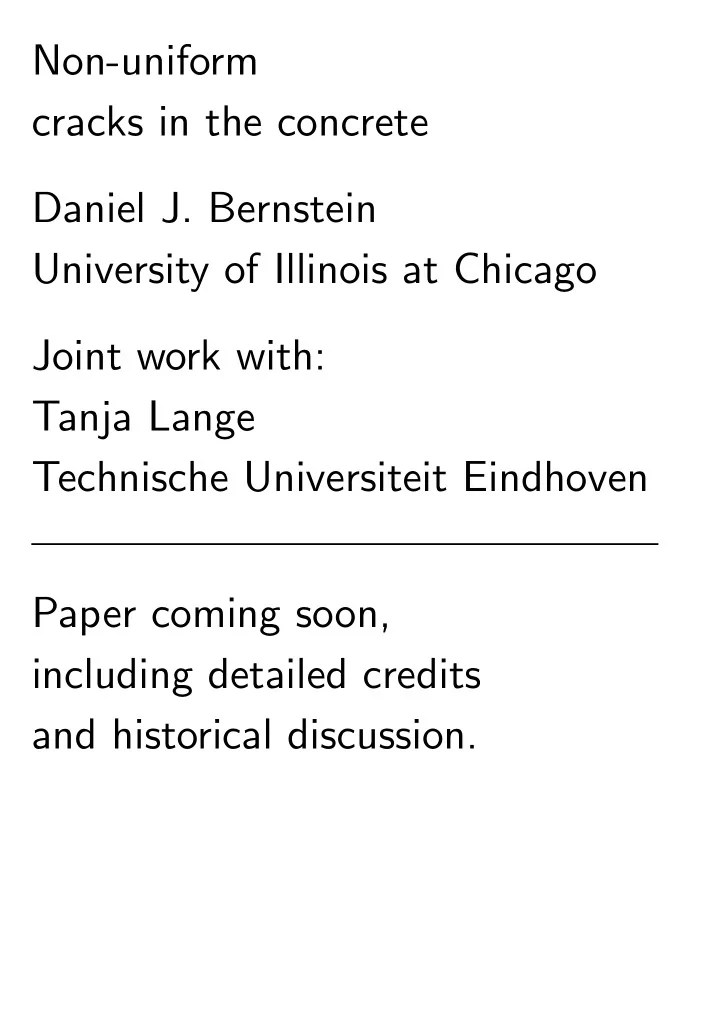

Non-uniform cracks in the concrete Daniel J. Bernstein University of Illinois at Chicago Joint work with: Tanja Lange Technische Universiteit Eindhoven Paper coming soon, including detailed credits and historical discussion.
Classic “concrete security” metric for cipher insecurity: “The maximum, over all adversaries restricted to q ✵ input-output examples and execution time t ✵ , of the ‘advantage’ that the adversary has in the game of distinguishing [the cipher for a secret key] from a random permutation.”
Attractive theorems: e.g., “ Adv prf CBC ♠ - ❋ ( q❀ t ) ✔ ❋ ( q ✵ ❀ t ✵ ) + q 2 ♠ 2 Adv prp 2 ❧ � 1 where q ✵ = ♠q and t ✵ = t + ❖ ( ♠q❧ ).”
Attractive theorems: e.g., “ Adv prf CBC ♠ - ❋ ( q❀ t ) ✔ ❋ ( q ✵ ❀ t ✵ ) + q 2 ♠ 2 Adv prp 2 ❧ � 1 where q ✵ = ♠q and t ✵ = t + ❖ ( ♠q❧ ).” Conjectured bounds on insecurity of specific ciphers that have survived cryptanalysis: e.g., “ Adv prp � cpa ( ✁ ✁ ✁ ) AES ✔ ❝ 1 ✁ t❂❚ AES q + ❝ 2 ✁ 2 128 .” 2 128
Similar public-key story. Define t -insecurity of RSA-1024 as maximum success probability of all attacks that cost ✔ t .
Similar public-key story. Define t -insecurity of RSA-1024 as maximum success probability of all attacks that cost ✔ t . Prove, e.g., that bounds on insecurity of RSA-1024 imply similar bounds on insecurity of RSA-1024-PSS.
Similar public-key story. Define t -insecurity of RSA-1024 as maximum success probability of all attacks that cost ✔ t . Prove, e.g., that bounds on insecurity of RSA-1024 imply similar bounds on insecurity of RSA-1024-PSS. Conjecture bounds on insecurity of RSA-1024: e.g., “it takes time ❈❡ 1 ✿ 923(log ◆ ) 1 ❂ 3 (log log ◆ ) 2 ❂ 3 to invert RSA”.
These conjectures are wrong. There exist algorithms breaking AES, RSA-3072, DSA-3072, and ECC-256 at cost far below 2 128 ; e.g., time 2 85 to break ECC-256. (Assuming standard heuristics.)
These conjectures are wrong. There exist algorithms breaking AES, RSA-3072, DSA-3072, and ECC-256 at cost far below 2 128 ; e.g., time 2 85 to break ECC-256. (Assuming standard heuristics.) No actual security problem: Finding these algorithms costs more than 2 128 .
These conjectures are wrong. There exist algorithms breaking AES, RSA-3072, DSA-3072, and ECC-256 at cost far below 2 128 ; e.g., time 2 85 to break ECC-256. (Assuming standard heuristics.) No actual security problem: Finding these algorithms costs more than 2 128 . ✮ Very large separation between standard definition and actual insecurity.
These conjectures are wrong. There exist algorithms breaking AES, RSA-3072, DSA-3072, and ECC-256 at cost far below 2 128 ; e.g., time 2 85 to break ECC-256. (Assuming standard heuristics.) No actual security problem: Finding these algorithms costs more than 2 128 . ✮ Very large separation between standard definition and actual insecurity. Undermines concrete-security evaluations and comparisons.
Several possible fixes, all causing trouble. Examples:
Several possible fixes, all causing trouble. Examples: 1. Add enough uniformity. Clearly stops attacks. Requires massive rewrite of theorems in literature. Abandons goal of defining concrete security of AES.
Several possible fixes, all causing trouble. Examples: 1. Add enough uniformity. Clearly stops attacks. Requires massive rewrite of theorems in literature. Abandons goal of defining concrete security of AES. 2. Switch to ❆❚ metric. Preserves goal of defining concrete security of AES. Seems to stop all attacks above reasonable Pr cutoff. Breaks more theorems.
Recommend
More recommend